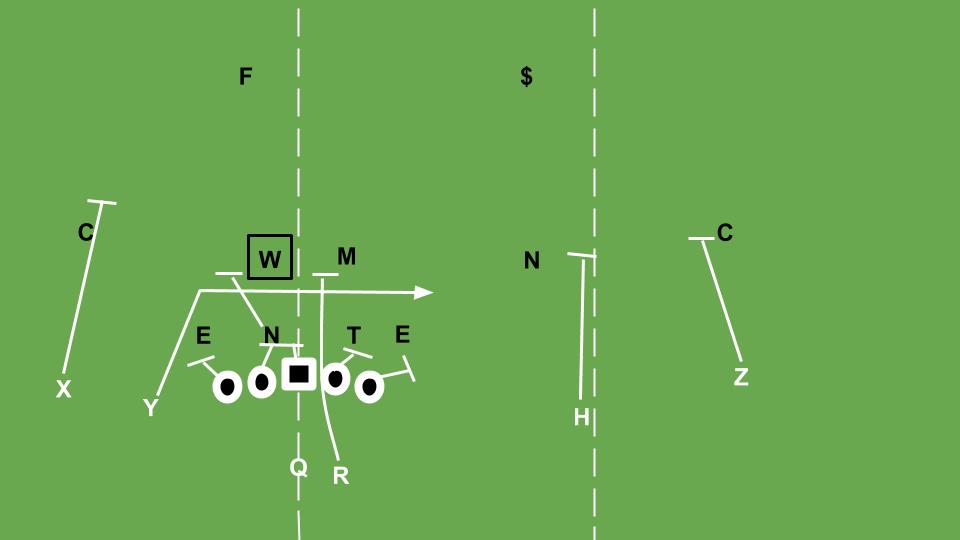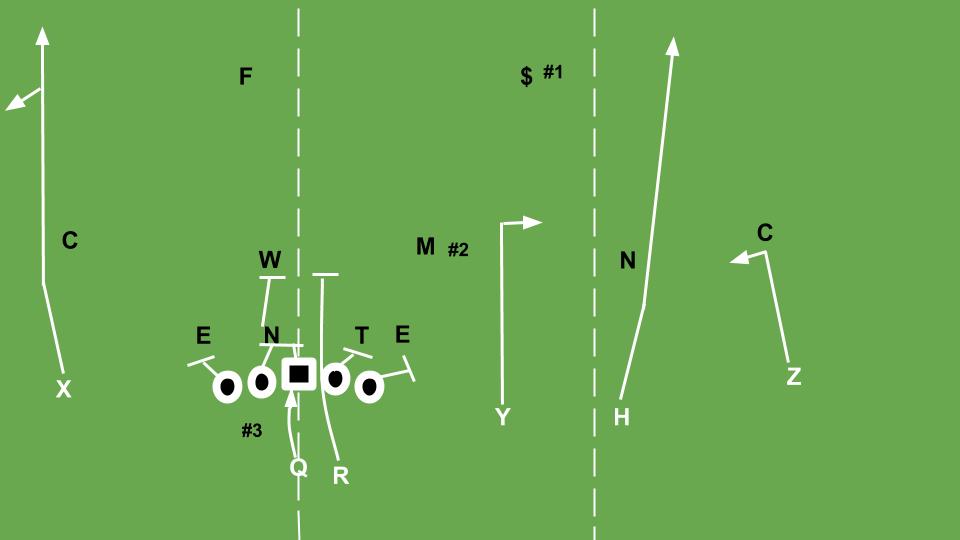It’s been something of a fad in football for people to talk about RPOs, but now we also have PROs and PPOs emerging as “the next big thing.”
If you need to back up multiple steps because all of those acronyms have completely left you behind don’t worry, this doesn’t have to be all that complicated.
The RPO (run/pass option)
RPO stands for “run/pass option” and these plays took the game by storm in this last decade. They became famous in part after Auburn beat Alabama in the 2013 Iron Bowl on a zone-read play where quarterback Nick Marshall pulled up on the edge and threw the ball to a wide open receiver in the flat for a huge gain. I wrote the following piece the next offseason about the game-changing trend.
The idea behind a RPO is really pretty simple. The offense calls a normal running play, but instead of having the wide receivers executing blocks that may or may not make a lick of difference in the play they run routes. Often they run routes into areas of the field that would normally be defended by defenders that also have run-stopping responsibilities.
Here’s your standard, simple example that you see from lots of Big 12 teams including Texas and Baylor.

This play is basically the foundation of the Texas offense, or at least how it’s been before Mike Yurcich became offensive coordinator and since they became more aggressive with their RPOs. The quarterback can read to either side of the field. Because the tight end is helping block on this play there are seven potential gaps for the RB to hit that the defense has to account for. But they have six guys in the box, so they need one extra guy.
If the nickel tries to play the edge outside of the tight end’s block, the quarterback can punish that by throwing a quick bubble screen to the H slot receiver. If the defense has the linebackers “rock back” towards the tight end and drops the free safety down to fit the gap the weakside linebacker is lined up across then the quarterback can throw it over his head to the X receiver on the glance route.
Baylor scored some touchdowns using this play but having the X receiver (Denzel Mims) run a fade route. The idea is to use the threat of the pass to create angles and advantages for the run game. It’s triple option football but instead of going:
- Dive
- Quarterback keep
- Quarterback pitch
It goes:
- Bubble OR glance route
- Hand-off
The PRO (pass/run option)
This is a new and fairly nebulous term. Technically, good RPO teams teach their quarterback to execute RPOs by throwing the pass if it’s there before handing off. You don’t choose the run first.
There’s also been some pass option schemes mixed in for a very, very long time in football. Check this play out from the 2007 Texas Longhorns.

This is the earliest form of RPO, where it’s mostly a pre-snap decision by the quarterback to punish off coverage by the cornerback with a quick toss outside. Quan Cosby was really hard to tackle in space, so when Colt McCoy sees Tech rotating into cover 3 before the snap and bailing their boundary corner 10 yards off the ball he can just flip it out there for an easy gain. Otherwise, Texas had a power run called and everyone else on the Longhorn offense is executing the power run.
You can find a clip of Brett Favre claiming to invent the RPO back in the 90s by asking his receiver to run a quick slant on some of their run plays if he saw the corner bailing deep.
What people generally today by PRO is some of the nasty stuff people are doing with the draw. Imo, this is the most deadly stuff and it’s also more NFL friendly because it carries less risk of breaking the “ineligible man downfield” rules. In college the offensive line can get up to three yards down the field before the ball is thrown beyond the line of scrimmage before they are penalized. In the NFL if they are more than one yard down the field it’s a flag.
The most famous PRO is probably this drag screen/quarterback draw play that Oklahoma invented.

The scheme is deadly simple. They run that slot receiver, Y in this instance, on a shallow or drag route across the middle underneath the linebackers. The other receivers feign like they’re running routes, mimicking the shallow cross combination, but they end up blocking downfield instead. The quarterback reads that weakside linebacker, if he chases the shallow screen then he can pull the ball and run into the vacated space. If he doesn’t, that screen tends to open up. Go watch some Dede Westbrook and Marquise Brown highlights and you’ll see them torching teams on this play, with Jalen Hurts it tended to be a draw.
Ironically though, one of the earliest “RPOs” was the stick-draw play, which was a common Air Raid scheme at the turn of the decade and most deadly when operated by Johnny Manziel at Texas A&M.

A&M had a dozen ways to run quarterback draw PRO, usually with a stick combination outside. They could have the running back motion out and Johnny would key the linebacker to see if he chased him (draw) or stayed home (throw the swing screen). They ran it with Johnny reading the linebacker to see if he covered the stick route from a #3 receiver or stayed home to defend the lead draw with the running back blocking. Or this version, where the running back is flexed out opposite the stick route and Johnny reads the linebacker but follows a pulling guard.
The stick-draw originally was the stick route holding the middle linebacker while the quarterback read him to see whether to hand off on a draw or not. By making it a quarterback lead draw, the offense got another +1 for the play and it became checkmate. Teams couldn’t really figure it out against Johnny.
Nowadays, teams will add even more dynamics to these types of plays. Like…

There’s a lot going on here.

It’s a common check for teams, including Alabama, to roll their linebackers to the underneath skill players and use the boundary safety to clean up behind them in the box. The Tide were in dime here and probably already using their dime and free safety to be 1/2 defenders in the box, coming late to clean up behind the nose and will linebacker.
LSU swings the running back wide, where they have the tight end out wide to help block, and that triggers the adjustments by Alabama’s linebackers and the safety insert. Then they have the quarterback draw play that for sure sucks in the safety, but they always wanted the glance route to Ja’Marr Chase. Pretty brutal.
Draw plays create all kinds of additional spacing and timing stress on the defense. If you want to defend a hard-hitting tight zone RPO you can try to move your defensive line around or rely on a great defensive tackle to tie them down and buy linebackers and safeties put into conflict by RPOs to stay flat-footed and refuse to commit to the run or the pass. That clouds the read for the quarterback and gives you a chance to rally and defend the play.
That’s harder with draws though, because the offensive line is selling pass blocks first and they aren’t getting downfield until such time as defenders have tended to commit to the run or the pass. There’s more time for the offense to work in and then more space because the defense gets spread out as they react to the initial moves by the offense.
You can add vertical pass combinations to draws, and not just with hard to execute throws like Joe Burrow pulls off above. You can run stick with quarterback lead draw and use the slot fade.

On this play the quarterback could look up at the strong safety to see if this was single high or two-deep. If it’s single-high he could take the slot fade shot in man coverage against the nickel. If it’s two high then it’s a normal stick draw play, reading the middle linebacker to see if he sticks around to stop the lead draw or drifts out to stop the Y receiver running that option route.
Texas has a play they’ve run a small handful of times in the red zone where they combine a quarterback draw with a flag route by the slot. Not every quarterback is good on the draw as it requires a combination of quickness/mobility with toughness to stick your nose between the tackles to find a running lane. The guys that have the legs and mind for it though can be deadly.
The PPO (pass/pass option)
This one is a little controversial. People don’t like the term because most every dropback play consists of the quarterback choosing between multiple “pass” options. There’s a subsection of passing plays though that are unique and the term is useful for describing them.
Most all of them involve screens. Basically you’re talking about quick game plays where the offense has two packaged together with very simple reads for the quarterback to use to know which one to throw. Stuff like this:

The Saints have Alvin Kamara running a bubble screen to one side of the field, to the other they have Michael Thomas running a slant. The Vikings show a blitz involving the middle linebacker so Brees flips the ball out to where the offense has two blockers for two defenders and then Kamara vs the deep 1/2 safety.
Another example you’ll see pretty often once again involves the stick route to a trips side. This time instead of pairing it with a draw, you pair it with a slip screen to the RB.

The y-stick combination is going to tend to draw defenders to the wide side of the field and thus buy time for the offensive line to get out and lead block for the running back slip screen.
Kansas State once had a play like this except that instead of using the running back slip screen, they’d have the quarterback drift over in that direction and run behind the offensive line. It was wild, I can only show you to convey the strangeness.

Only the purple wizard could draw up a play that’s essentially a screen pass to the quarterback, and only old Bill Snyder would even think to try to do something like that.
In truth, you can see a lot of this stuff in the 2010s Kansas State offenses. They were ahead of the curve on RPOs, PPOs, and PROs in particular with a ton of plays akin to the one you see LSU torching Alabama with above. This is why they were able to get so much mileage out of a limited roster.
Hopefully now everyone is familiar with these acronyms if/when you see them pop up in the coming football seasons.
********
Read more about advanced offenses and the rise of the RPO in my book!

Monday morning buffet | Get The Picture
[…] Ian Boyd explains the difference between RPOs, PROs and PPOs. […]